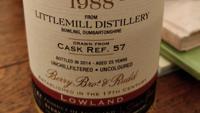What is a non-chill filtered whisky?

If you often drink whisky you have probably heard about chill filtering and enthusiastic drinkers favouring non-chill filtered whiskies. But what exactly does this mean? That is a frequently asked question that we will answer in this article. We will also look at what effect these methods have on your final whisky. Before we talk about non-chill filtered (or un-chillfiltered) whisky, let’s first explain what chill filtering exactly means and how this process works.
Chill filtering during whisky production
The term chill filtering refers to an optional part of the whisky production process. As the name suggests, whisky is first chilled and then filtered. Just before bottling the whisky is cooled to a temperature around freezing point. As a result, certain substances, such as fatty acids, proteins and esters, clump together and get stuck in a special metal filter.
Why are whiskies chill filtered?
The only reason for chill filtration is cosmetic, or more accurately marketing as non-chill filtered whiskies can become cloudy if borrled below 43% abv. Perhaps you have experienced it yourself. You have just bought a whisky, and just before you want to pour a glass you notice that the whisky has become cloudy. This is caused by the above substances, which make the whisky cloudy when stored in a low temperature for a long time. Adding cold water or ice also causes the whisky to become cloudy.
Because a cloudy bottle of whisky may not be desirable to consumers, many distilleries use the chill filtering method to remove substances that cause this. Exactly how much matter is removed during filtering depends on several factors, such as the temperature, the number of filters and the speed at which the whisky is passed through the filter. At a lower speed and the use of multiple filters, more matter is naturally removed.
##Whisky with a non-chill filtered label Many distilleries today skip the chill filtering process. They proudly place the label non-chill filtered on the whisky label . They claim that the filtering has a negative effect on the taste of the whisky. Fatty acids and esters add a large amount of flavor to the whisky. By skipping the chill filtering process, these flavors are not lost. Skipping this step also reduces production costs.
In general, whiskies with an alcohol content of 43-46% or higher are non-chill filtered. There are, of course, a few exceptions. Up until 2021 Glendronach also bottled without chill-filtration on the label, while they have declared that this is merely a labelling choice the fear is that this unforunate development will signal a change in production at some point.
There is also quite a bit of discussion about whether chill filtering actually has a negative effect on the taste. Some argue that the difference is barely noticeable. This is supported by a german study into chill filtering, where whisky connoisseurs were able to make the distinction only around 45% of the time. The conclusion of the study is therefore that chill filtering is difficult to identify by the ordinary consumer.
A personal experiment
I tried it myself by filtering three non-chilled filtered whiskies myself. Place a small amount in the freezer and then run several times through a fine mesh filter then I tasted these blind in coloured glasses. At first I tasted little or no difference. I couldn’t tell them apart blind and didn’t score much better than if I had just bet heads or tails.
On a subsequent attempt, instead of focussing on taste, and instead relying on mouthfeel I was far more accurate. When I did that, I scored almost 100% (I was wrong once). My experience is that the taste does not suffer much, but that especially the mouthfeel changes. Chill-filtered whiskies feel less greasy and thinner in the mouth.
Unltimately it doesn’t really matter to me whether and how a whisky is filtered. In the end, it’s about the entire experience of smell and taste. If it’s good for me, the whisky is good. while I would always prefer to drink my whisky non-chill filtered, and without E150a I’m not going to pass up a great whisky because of a marketing decision.
FAQs
What does no chill-filtered mean on a whisky?
No chill-filtered on a whisky indicates that it has been bottled without chill filtration. Chill-filtering is a process that is commonly used to remove certain compounds from a whisky, such as fatty acids and esters, which can cause the whisky to appear hazy when it is chilled or diluted.
What is the difference between chill-filtered and non-chill filtered?
Chill-filtered whisky, have had certain flavour and aroma compounds such fatty acids and esters removed, a non-chill filtered whisky has not undergone this process and so may appear hazy when it is chilled or diluted. Some people prefer to drink whiskies that have not been chill-filtered, as they believe it gives the whisky a more full-bodied flavor and mouthfeel.
Does chill filtering affect taste?
Yes. Chill-filtering affects the flavour of a whisky by removing certain compounds that contribute to its taste and mouthfeel. In general, non-chill-filtered whiskies are thought to have a fuller body and a richer flavor than chill-filtered whiskies.
What whiskies and bourbons are not chill-filtered?
Most non-chill-filtered bourbons are higher abv (usually past 46% or 92 proof) though these can be as low as 43% abv or 86% proof.
Previous

